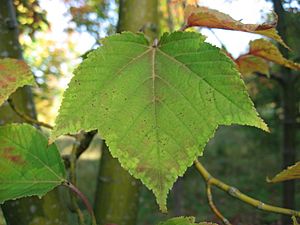Acer palaeorufinerve facts for kids
Quick facts for kids Acer palaeorufinerve |
|
|---|---|
| Scientific classification |
Acer palaeorufinerve is an extinct type of maple tree. We know about it from fossils of its leaves and winged seeds, called samaras. These fossils are from the Miocene and Pliocene periods, which were millions of years ago. Scientists have found them in Japan, Korea, and even Alaska in the USA. This ancient maple is part of a group of maples called Macrantha, which still has living members today.
Discovering This Ancient Maple
Scientists have found fossils of Acer palaeorufinerve in several different places.
- The first fossils were found in Japan. They came from a rock layer called the Pliocene Ningyo-toge Formation.
- Later, more fossils were discovered in other Japanese rock layers. These included the Late Miocene Tatsumitoge Formation and the Early Miocene Ito-o Formation.
- Fossils have also been found in North Korea and Russia.
- A single fossil seed, possibly from A. palaeorufinerve, was found in North America. It came from the Seldovia Point area in Alaska.
What Acer palaeorufinerve Looked Like
The leaves of Acer palaeorufinerve were simple. They had veins that spread out from the base, a bit like fingers from the palm of your hand.
- These leaves usually had three or five lobes, giving them a shape like a pentagon.
- One fossil leaf was about 7.2 centimeters (2.8 inches) long and 6.0 centimeters (2.4 inches) wide.
- The seeds, or samaras, were flat and had a high angle where the wing attached.
Scientists believe A. palaeorufinerve belongs to the Acer section Macrantha. This is because its leaves have a similar overall shape and long, pointed tips. Its features are most like those of a living maple species called Acer rufinerve, also known as the redvein maple.
Another fossil maple, Acer latahense, found in Washington state and Oregon, is different. Its middle lobe is narrower than that of A. palaeorufinerve. Some scientists think A. latahense might have developed from A. palaeorufinerve.
Images for kids



